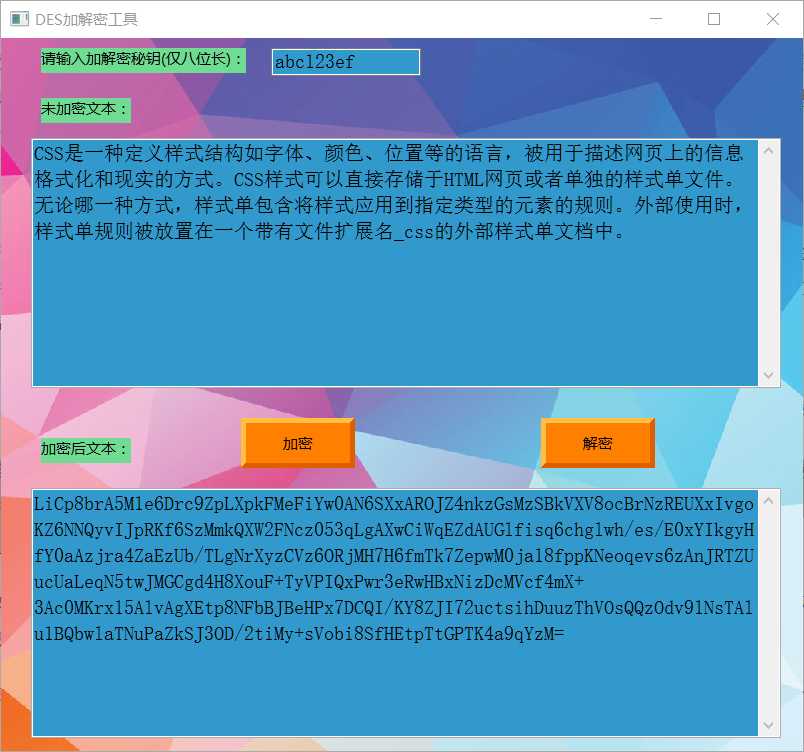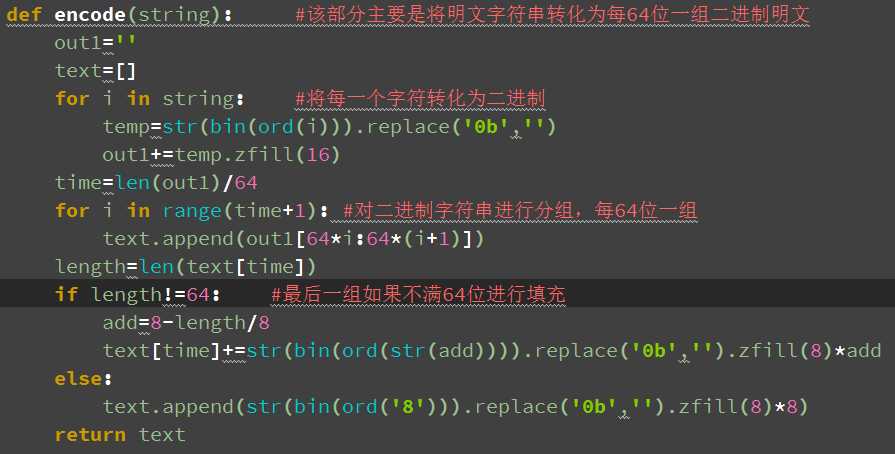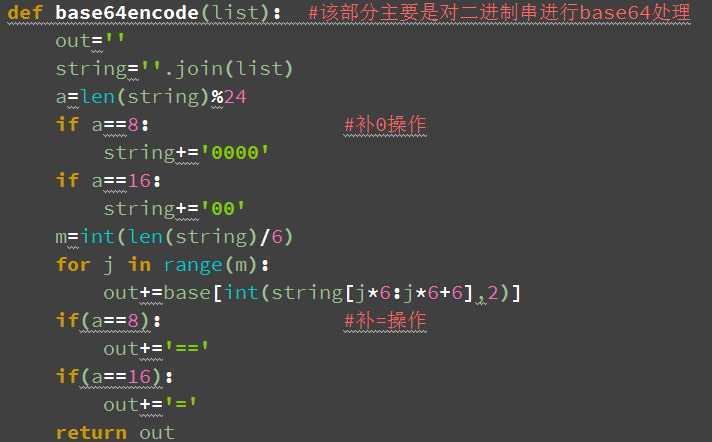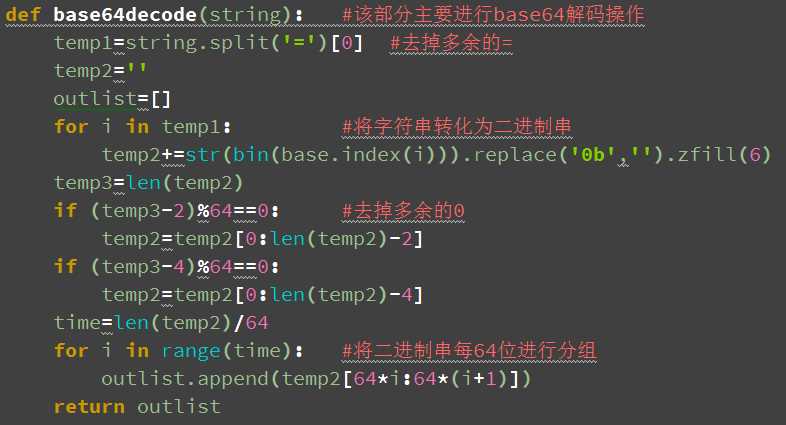用C语言来实现DES加密算法(很急)两天内
Posted
tags:
篇首语:本文由小常识网(cha138.com)小编为大家整理,主要介绍了用C语言来实现DES加密算法(很急)两天内相关的知识,希望对你有一定的参考价值。
谁能帮我写个简单点的用C语言来实现DES加密算法,需要运行结果,还有要写出程序由哪些函数组成,函数之间的关系,每个函数的原型及功能.
这样才能给分...
这个太复杂了,我想要个简单点的...要有内容分析才能给分啊...
楼下的那个算法运行不出来啊...
还有要能运行的出来的...找了N多都是运行不出来的,嫌分数的少的,我可以追加,重要的是给我做出一个能运行的,并帮我分析这个编程有哪些函数构成,各个函数的功能是什么?
#include "pch.h"
#include "misc.h"
#include "des.h"
NAMESPACE_BEGIN(CryptoPP)
/* Tables defined in the Data Encryption Standard documents
* Three of these tables, the initial permutation, the final
* permutation and the expansion operator, are regular enough that
* for speed, we hard-code them. They\'re here for reference only.
* Also, the S and P boxes are used by a separate program, gensp.c,
* to build the combined SP box, Spbox[]. They\'re also here just
* for reference.
*/
#ifdef notdef
/* initial permutation IP */
static byte ip[] =
58, 50, 42, 34, 26, 18, 10, 2,
60, 52, 44, 36, 28, 20, 12, 4,
62, 54, 46, 38, 30, 22, 14, 6,
64, 56, 48, 40, 32, 24, 16, 8,
57, 49, 41, 33, 25, 17, 9, 1,
59, 51, 43, 35, 27, 19, 11, 3,
61, 53, 45, 37, 29, 21, 13, 5,
63, 55, 47, 39, 31, 23, 15, 7
;
/* final permutation IP^-1 */
static byte fp[] =
40, 8, 48, 16, 56, 24, 64, 32,
39, 7, 47, 15, 55, 23, 63, 31,
38, 6, 46, 14, 54, 22, 62, 30,
37, 5, 45, 13, 53, 21, 61, 29,
36, 4, 44, 12, 52, 20, 60, 28,
35, 3, 43, 11, 51, 19, 59, 27,
34, 2, 42, 10, 50, 18, 58, 26,
33, 1, 41, 9, 49, 17, 57, 25
;
/* expansion operation matrix */
static byte ei[] =
32, 1, 2, 3, 4, 5,
4, 5, 6, 7, 8, 9,
8, 9, 10, 11, 12, 13,
12, 13, 14, 15, 16, 17,
16, 17, 18, 19, 20, 21,
20, 21, 22, 23, 24, 25,
24, 25, 26, 27, 28, 29,
28, 29, 30, 31, 32, 1
;
/* The (in)famous S-boxes */
static byte sbox[8][64] =
/* S1 */
14, 4, 13, 1, 2, 15, 11, 8, 3, 10, 6, 12, 5, 9, 0, 7,
0, 15, 7, 4, 14, 2, 13, 1, 10, 6, 12, 11, 9, 5, 3, 8,
4, 1, 14, 8, 13, 6, 2, 11, 15, 12, 9, 7, 3, 10, 5, 0,
15, 12, 8, 2, 4, 9, 1, 7, 5, 11, 3, 14, 10, 0, 6, 13,
/* S2 */
15, 1, 8, 14, 6, 11, 3, 4, 9, 7, 2, 13, 12, 0, 5, 10,
3, 13, 4, 7, 15, 2, 8, 14, 12, 0, 1, 10, 6, 9, 11, 5,
0, 14, 7, 11, 10, 4, 13, 1, 5, 8, 12, 6, 9, 3, 2, 15,
13, 8, 10, 1, 3, 15, 4, 2, 11, 6, 7, 12, 0, 5, 14, 9,
/* S3 */
10, 0, 9, 14, 6, 3, 15, 5, 1, 13, 12, 7, 11, 4, 2, 8,
13, 7, 0, 9, 3, 4, 6, 10, 2, 8, 5, 14, 12, 11, 15, 1,
13, 6, 4, 9, 8, 15, 3, 0, 11, 1, 2, 12, 5, 10, 14, 7,
1, 10, 13, 0, 6, 9, 8, 7, 4, 15, 14, 3, 11, 5, 2, 12,
/* S4 */
7, 13, 14, 3, 0, 6, 9, 10, 1, 2, 8, 5, 11, 12, 4, 15,
13, 8, 11, 5, 6, 15, 0, 3, 4, 7, 2, 12, 1, 10, 14, 9,
10, 6, 9, 0, 12, 11, 7, 13, 15, 1, 3, 14, 5, 2, 8, 4,
3, 15, 0, 6, 10, 1, 13, 8, 9, 4, 5, 11, 12, 7, 2, 14,
/* S5 */
2, 12, 4, 1, 7, 10, 11, 6, 8, 5, 3, 15, 13, 0, 14, 9,
14, 11, 2, 12, 4, 7, 13, 1, 5, 0, 15, 10, 3, 9, 8, 6,
4, 2, 1, 11, 10, 13, 7, 8, 15, 9, 12, 5, 6, 3, 0, 14,
11, 8, 12, 7, 1, 14, 2, 13, 6, 15, 0, 9, 10, 4, 5, 3,
/* S6 */
12, 1, 10, 15, 9, 2, 6, 8, 0, 13, 3, 4, 14, 7, 5, 11,
10, 15, 4, 2, 7, 12, 9, 5, 6, 1, 13, 14, 0, 11, 3, 8,
9, 14, 15, 5, 2, 8, 12, 3, 7, 0, 4, 10, 1, 13, 11, 6,
4, 3, 2, 12, 9, 5, 15, 10, 11, 14, 1, 7, 6, 0, 8, 13,
/* S7 */
4, 11, 2, 14, 15, 0, 8, 13, 3, 12, 9, 7, 5, 10, 6, 1,
13, 0, 11, 7, 4, 9, 1, 10, 14, 3, 5, 12, 2, 15, 8, 6,
1, 4, 11, 13, 12, 3, 7, 14, 10, 15, 6, 8, 0, 5, 9, 2,
6, 11, 13, 8, 1, 4, 10, 7, 9, 5, 0, 15, 14, 2, 3, 12,
/* S8 */
13, 2, 8, 4, 6, 15, 11, 1, 10, 9, 3, 14, 5, 0, 12, 7,
1, 15, 13, 8, 10, 3, 7, 4, 12, 5, 6, 11, 0, 14, 9, 2,
7, 11, 4, 1, 9, 12, 14, 2, 0, 6, 10, 13, 15, 3, 5, 8,
2, 1, 14, 7, 4, 10, 8, 13, 15, 12, 9, 0, 3, 5, 6, 11
;
/* 32-bit permutation function P used on the output of the S-boxes */
static byte p32i[] =
16, 7, 20, 21,
29, 12, 28, 17,
1, 15, 23, 26,
5, 18, 31, 10,
2, 8, 24, 14,
32, 27, 3, 9,
19, 13, 30, 6,
22, 11, 4, 25
;
#endif
/* permuted choice table (key) */
static const byte pc1[] =
57, 49, 41, 33, 25, 17, 9,
1, 58, 50, 42, 34, 26, 18,
10, 2, 59, 51, 43, 35, 27,
19, 11, 3, 60, 52, 44, 36,
63, 55, 47, 39, 31, 23, 15,
7, 62, 54, 46, 38, 30, 22,
14, 6, 61, 53, 45, 37, 29,
21, 13, 5, 28, 20, 12, 4
;
/* number left rotations of pc1 */
static const byte totrot[] =
1,2,4,6,8,10,12,14,15,17,19,21,23,25,27,28
;
/* permuted choice key (table) */
static const byte pc2[] =
14, 17, 11, 24, 1, 5,
3, 28, 15, 6, 21, 10,
23, 19, 12, 4, 26, 8,
16, 7, 27, 20, 13, 2,
41, 52, 31, 37, 47, 55,
30, 40, 51, 45, 33, 48,
44, 49, 39, 56, 34, 53,
46, 42, 50, 36, 29, 32
;
/* End of DES-defined tables */
/* bit 0 is left-most in byte */
static const int bytebit[] =
0200,0100,040,020,010,04,02,01
;
/* Set key (initialize key schedule array) */
DES::DES(const byte *key, CipherDir dir)
: k(32)
SecByteBlock buffer(56+56+8);
byte *const pc1m=buffer; /* place to modify pc1 into */
byte *const pcr=pc1m+56; /* place to rotate pc1 into */
byte *const ks=pcr+56;
register int i,j,l;
int m;
for (j=0; j<56; j++) /* convert pc1 to bits of key */
l=pc1[j]-1; /* integer bit location */
m = l & 07; /* find bit */
pc1m[j]=(key[l>>3] & /* find which key byte l is in */
bytebit[m]) /* and which bit of that byte */
? 1 : 0; /* and store 1-bit result */
for (i=0; i<16; i++) /* key chunk for each iteration */
memset(ks,0,8); /* Clear key schedule */
for (j=0; j<56; j++) /* rotate pc1 the right amount */
pcr[j] = pc1m[(l=j+totrot[i])<(j<28? 28 : 56) ? l: l-28];
/* rotate left and right halves independently */
for (j=0; j<48; j++) /* select bits individually */
/* check bit that goes to ks[j] */
if (pcr[pc2[j]-1])
/* mask it in if it\'s there */
l= j % 6;
ks[j/6] |= bytebit[l] >> 2;
/* Now convert to odd/even interleaved form for use in F */
k[2*i] = ((word32)ks[0] << 24)
| ((word32)ks[2] << 16)
| ((word32)ks[4] << 8)
| ((word32)ks[6]);
k[2*i+1] = ((word32)ks[1] << 24)
| ((word32)ks[3] << 16)
| ((word32)ks[5] << 8)
| ((word32)ks[7]);
if (dir==DECRYPTION) // reverse key schedule order
for (i=0; i<16; i+=2)
std::swap(k[i], k[32-2-i]);
std::swap(k[i+1], k[32-1-i]);
/* End of C code common to both versions */
/* C code only in portable version */
// Richard Outerbridge\'s initial permutation algorithm
/*
inline void IPERM(word32 &left, word32 &right)
word32 work;
work = ((left >> 4) ^ right) & 0x0f0f0f0f;
right ^= work;
left ^= work << 4;
work = ((left >> 16) ^ right) & 0xffff;
right ^= work;
left ^= work << 16;
work = ((right >> 2) ^ left) & 0x33333333;
left ^= work;
right ^= (work << 2);
work = ((right >> 8) ^ left) & 0xff00ff;
left ^= work;
right ^= (work << 8);
right = rotl(right, 1);
work = (left ^ right) & 0xaaaaaaaa;
left ^= work;
right ^= work;
left = rotl(left, 1);
inline void FPERM(word32 &left, word32 &right)
word32 work;
right = rotr(right, 1);
work = (left ^ right) & 0xaaaaaaaa;
left ^= work;
right ^= work;
left = rotr(left, 1);
work = ((left >> 8) ^ right) & 0xff00ff;
right ^= work;
left ^= work << 8;
work = ((left >> 2) ^ right) & 0x33333333;
right ^= work;
left ^= work << 2;
work = ((right >> 16) ^ left) & 0xffff;
left ^= work;
right ^= work << 16;
work = ((right >> 4) ^ left) & 0x0f0f0f0f;
left ^= work;
right ^= work << 4;
*/
// Wei Dai\'s modification to Richard Outerbridge\'s initial permutation
// algorithm, this one is faster if you have access to rotate instructions
// (like in MSVC)
inline void IPERM(word32 &left, word32 &right)
word32 work;
right = rotl(right, 4U);
work = (left ^ right) & 0xf0f0f0f0;
left ^= work;
right = rotr(right^work, 20U);
work = (left ^ right) & 0xffff0000;
left ^= work;
right = rotr(right^work, 18U);
work = (left ^ right) & 0x33333333;
left ^= work;
right = rotr(right^work, 6U);
work = (left ^ right) & 0x00ff00ff;
left ^= work;
right = rotl(right^work, 9U);
work = (left ^ right) & 0xaaaaaaaa;
left = rotl(left^work, 1U);
right ^= work;
inline void FPERM(word32 &left, word32 &right)
word32 work;
right = rotr(right, 1U);
work = (left ^ right) & 0xaaaaaaaa;
right ^= work;
left = rotr(left^work, 9U);
work = (left ^ right) & 0x00ff00ff;
right ^= work;
left = rotl(left^work, 6U);
work = (left ^ right) & 0x33333333;
right ^= work;
left = rotl(left^work, 18U);
work = (left ^ right) & 0xffff0000;
right ^= work;
left = rotl(left^work, 20U);
work = (left ^ right) & 0xf0f0f0f0;
right ^= work;
left = rotr(left^work, 4U);
// Encrypt or decrypt a block of data in ECB mode
void DES::ProcessBlock(const byte *inBlock, byte * outBlock) const
word32 l,r,work;
#ifdef IS_LITTLE_ENDIAN
l = byteReverse(*(word32 *)inBlock);
r = byteReverse(*(word32 *)(inBlock+4));
#else
l = *(word32 *)inBlock;
r = *(word32 *)(inBlock+4);
#endif
IPERM(l,r);
const word32 *kptr=k;
for (unsigned i=0; i<8; i++)
work = rotr(r, 4U) ^ kptr[4*i+0];
l ^= Spbox[6][(work) & 0x3f]
^ Spbox[4][(work >> 8) & 0x3f]
^ Spbox[2][(work >> 16) & 0x3f]
^ Spbox[0][(work >> 24) & 0x3f];
work = r ^ kptr[4*i+1];
l ^= Spbox[7][(work) & 0x3f]
^ Spbox[5][(work >> 8) & 0x3f]
^ Spbox[3][(work >> 16) & 0x3f]
^ Spbox[1][(work >> 24) & 0x3f];
work = rotr(l, 4U) ^ kptr[4*i+2];
r ^= Spbox[6][(work) & 0x3f]
^ Spbox[4][(work >> 8) & 0x3f]
^ Spbox[2][(work >> 16) & 0x3f]
^ Spbox[0][(work >> 24) & 0x3f];
work = l ^ kptr[4*i+3];
r ^= Spbox[7][(work) & 0x3f]
^ Spbox[5][(work >> 8) & 0x3f]
^ Spbox[3][(work >> 16) & 0x3f]
^ Spbox[1][(work >> 24) & 0x3f];
FPERM(l,r);
#ifdef IS_LITTLE_ENDIAN
*(word32 *)outBlock = byteReverse(r);
*(word32 *)(outBlock+4) = byteReverse(l);
#else
*(word32 *)outBlock = r;
*(word32 *)(outBlock+4) = l;
#endif
void DES_EDE_Encryption::ProcessBlock(byte *inoutBlock) const
e.ProcessBlock(inoutBlock);
d.ProcessBlock(inoutBlock);
e.ProcessBlock(inoutBlock);
void DES_EDE_Encryption::ProcessBlock(const byte *inBlock, byte *outBlock) const
e.ProcessBlock(inBlock, outBlock);
d.ProcessBlock(outBlock);
e.ProcessBlock(outBlock);
void DES_EDE_Decryption::ProcessBlock(byte *inoutBlock) const
d.ProcessBlock(inoutBlock);
e.ProcessBlock(inoutBlock);
d.ProcessBlock(inoutBlock);
void DES_EDE_Decryption::ProcessBlock(const byte *inBlock, byte *outBlock) const
d.ProcessBlock(inBlock, outBlock);
e.ProcessBlock(outBlock);
d.ProcessBlock(outBlock);
void TripleDES_Encryption::ProcessBlock(byte *inoutBlock) const
e1.ProcessBlock(inoutBlock);
d.ProcessBlock(inoutBlock);
e2.ProcessBlock(inoutBlock);
void TripleDES_Encryption::ProcessBlock(const byte *inBlock, byte *outBlock) const
e1.ProcessBlock(inBlock, outBlock);
d.ProcessBlock(outBlock);
e2.ProcessBlock(outBlock);
void TripleDES_Decryption::ProcessBlock(byte *inoutBlock) const
d1.ProcessBlock(inoutBlock);
e.ProcessBlock(inoutBlock);
d2.ProcessBlock(inoutBlock);
void TripleDES_Decryption::ProcessBlock(const byte *inBlock, byte *outBlock) const
d1.ProcessBlock(inBlock, outBlock);
e.ProcessBlock(outBlock);
d2.ProcessBlock(outBlock);
参考技术A 分也太少了,先做做 参考技术B S盒用默认的吗???
分太少了,要不然就给你写了。。。 参考技术C OPenSSL
Python实现DES加密算法的文本加密器
这是自行制作的一个DES文本加密工具
最终效果图:

本加密器支持UTF-8字符的加解密(包含中文),由于其中的编码方式与常用编码方式不同,加密结果与网上工具不同,但是能实现正常加解密。
最终目标:
目的是设计一个基于ECB模式,短块加密使用填充法的DES加密解密器,以此来实现对文本的加解密,其文本的处理还用到了base64编码。
实验内容:
该des加密软件我采用的是python语言编写。主程序分了四个大的模块,
一个负责图形化界面的编写及综合作用的mainfunc.py文件;
一个负责DES的加解密的DES.py文件;
一个负责字符串的处理以及base64编码的handle.py文件;
最后一个setup.py用于打包程序
以下将做详细介绍。
首先来介绍软解加解密的主要流程
对秘钥的处理:
由于用户输入的秘钥是8个字符,故首先要将其转化为64位的二进制字符串,该功能由handle.py中的keyencode函数实现:

加密流程:
1用户输入的明文为任意字符串(包含中文字符以及英文字母以及标点符号),首先要进行分组处理,分组成64位二进制一组的二进制字符串,最后一组不足64位的使用填充法,该部分由handle.py中的encode函数处理

2 接着根据之前得到的64位秘钥以及明文,依次进行DES加密,得到包含所有64位密文的数组
3 接着要将各64位的密文连在一起得到二进制的密文字符串,再对其进行base64编码得到最终的输出字符串,该部分由handle.py中的base64encode函数处理。

解密流程:
1 解密首先要对得到的密文字符串进行反base64编码处理,去掉后面添加的‘=’,接着将其根据base64的编码规则转化为二进制字符串,然后去掉之前添加的‘0’字符,然后将字符串进行分组,分为64位一组。这一部分由handle.py中的base64decode函数完成。

2接着根据之前得到的64位秘钥以及密文,依次进行DES解密,得到包含所有64位明文的数组。
3接着要对得到的包含所有64位明文的数组进行处理,首先去掉之前填充的多余的字符,接着对二进制字符串进行反编码得到源字符串。该部分由handle.py中的decode函数得到。

DES部分:
接着来编写DES加密模块,DES加解密流程完全按照书本上DES加解密流程实现,实现过程也没有什么难点,在此就不做过多介绍。
实验难点:
本次实验的DES加解密编程较为顺利,在字符串的操作上开始遇到了一点困难,之后比较顺利。主要是在字符串与二进制串的转换,字符编码上遇到了一些问题。
1.填充法的选择
由于初始的明文转化为64位二进制字符串后,最后一组并不一定是64位,故要进行处理,我这里运用的是比较直观的填充法,具体是PKCS5方法,在PKCS5方法中Block = 8bytes。Padding特点:对于Block=8bytes(64bits块)进行填充字节的值的取值范围在[1, 8].解码过程中,从最后一个字节看起,首先确定它表示的值1<=n<=8,然后检验最后n个字节的值是否相同,若相同最后删去最后n个字节即可得到完整的信息.特殊情况:若字符串恰好够分成完整的块,不多不少.则最后8个字节为:(IN HEX) 08 08 08 08 08 08 08 08
我在代码中已经实现:

2.中英文编码
这个问题实则比较麻烦,在我使用的python2.7版本中默认英文字符占一个字节,即八位,中文字符占据两个字节,即两个字节。如果中英文混在一起将无法区分。
一开始,我想到的解决方法是将中文字符16位中最高位置1,因为英文8位最高位为0,故可以将其区分,解码时在进行还原。但结果发现,有一部分中文字符最高位为0,故此法不通。
因此,我只好将英文字符也扩展到16位,高8位置0,我最终的代码也按此实现,但是此方法对加密的安全性应该有一定的影响。例如,对于全英文的文本,所需要破解的字符串瞬间减到一半。
但暂时没有想到更好的方法。
以下为我的代码实现:

附上最终源码:
mainfunc.py
#-*- coding=utf-8 -*-
import wx
import wx.lib.buttons as buttons
from lib import DES
from lib import handle
class newframe(wx.Frame):
def __init__(self): #主框架
wx.Frame.__init__(self,None,-1,u‘DES加解密工具‘,size=(820,760),pos=(500,100))
self.SetMinSize((820,760))
self.SetMaxSize((820,760))
self.panel=wx.Panel(self,-1)
self.panelpic=wx.Image(‘./diary.jpg‘,wx.BITMAP_TYPE_JPEG,).Scale(820,760).ConvertToBitmap()
self.picbk=wx.StaticBitmap(parent=self.panel,pos=(0,0),bitmap=self.panelpic)
self.initstatictext()
self.textctrl()
self.buttoninit()
self.buttonbind()
def initstatictext(self): #定义文本
self.text1=wx.StaticText(self.picbk,-1,u‘请输入加解密秘钥(仅八位长):‘,pos=(40,10),size=(-1,25),style=wx.TE_CENTER)#,size=(240,25))
self.text2=wx.StaticText(self.picbk,-1,u‘未加密文本:‘,pos=(40,60),size=(-1,25),style=wx.TE_CENTER)#,size=(240,25))
self.text3=wx.StaticText(self.picbk,-1,u‘加密后文本:‘,pos=(40,400),size=(-1,25),style=wx.TE_CENTER)#,size=(240,25))
self.text1.SetBackgroundColour(‘AQUAMARINE‘)
self.text2.SetBackgroundColour(‘AQUAMARINE‘)
self.text3.SetBackgroundColour(‘AQUAMARINE‘)
def textctrl(self): #定义文本框
font2 = wx.Font(12, wx.DECORATIVE, wx.NORMAL, wx.NORMAL)
self.ctrl1=wx.TextCtrl(self.picbk,-1,‘‘,pos=(30,100),size=(750,250), style=wx.TE_MULTILINE|wx.TE_RICH2)
self.ctrl1.SetBackgroundColour(‘sky blue‘)
self.ctrl1.SetFont(font2)
self.ctrl2=wx.TextCtrl(self.picbk,-1,‘‘,pos=(270,10),size=(150,28))
self.ctrl2.SetBackgroundColour(‘sky blue‘)
self.ctrl2.SetFont(font2)
self.ctrl3=wx.TextCtrl(self.picbk,-1,‘‘,pos=(30,450),size=(750,250), style=wx.TE_MULTILINE|wx.TE_RICH2)
self.ctrl3.SetBackgroundColour(‘sky blue‘)
self.ctrl3.SetFont(font2)
def buttoninit(self): #定义按钮
self.button1=buttons.GenButton(self.picbk,-1,u‘加密‘,pos=(240,380),size=(-1,50))
self.button2=buttons.GenButton(self.picbk,-1,u‘解密‘,pos=(540,380),size=(-1,50))
self.button1.SetBezelWidth(5)
self.button2.SetBezelWidth(5)
self.button1.SetBackgroundColour("CORAL")
self.button2.SetBackgroundColour("CORAL")
def buttonbind(self): #按钮事件绑定
self.button1.Bind(wx.EVT_BUTTON,self.encode)
self.button2.Bind(wx.EVT_BUTTON,self.decode)
def encode(self,evt): #加密事件
out=[]
password=self.ctrl2.GetValue()
password=handle.keyencode(password)
text=self.ctrl1.GetValue()
text=handle.encode(text)
for one in text:
a=DES.desencode(password,one)
out.append(a)
cipher=handle.base64encode(out)
self.ctrl3.SetLabelText(cipher)
def decode(self,evt): #解密事件
cipherlist=[]
outlist=[]
password=self.ctrl2.GetValue()
password=handle.keyencode(password)
ciphertext=self.ctrl3.GetValue()
cipherlist=handle.base64decode(ciphertext)
for one in cipherlist:
outlist.append(DES.desdecode(password,one))
outstring=handle.decode(outlist)
self.ctrl1.SetLabelText(outstring)
if __name__==‘__main__‘:
newapp=wx.App(False)
frame=newframe()
frame.Show()
newapp.MainLoop()
handle.py
#-*- coding=utf-8 -*-
base=‘ABCDEFGHIJKLMNOPQRSTUVWXYZabcdefghijklmnopqrstuvwxyz0123456789+/‘
def keyencode(key): #该部分将秘钥串转化为64位二进制形式
out=‘‘
for i in key: #将每一个字符转化为二进制形式
out+=str(bin(ord(i))).replace(‘0b‘,‘‘).zfill(8)
return out
def encode(string): #该部分主要是将明文字符串转化为每64位一组二进制明文
out1=‘‘
text=[]
for i in string: #将每一个字符转化为二进制
temp=str(bin(ord(i))).replace(‘0b‘,‘‘)
out1+=temp.zfill(16)
time=len(out1)/64
for i in range(time+1): #对二进制字符串进行分组,每64位一组
text.append(out1[64*i:64*(i+1)])
length=len(text[time])
if length!=64: #最后一组如果不满64位进行填充
add=8-length/8
text[time]+=str(bin(ord(str(add)))).replace(‘0b‘,‘‘).zfill(8)*add
else:
text.append(str(bin(ord(‘8‘))).replace(‘0b‘,‘‘).zfill(8)*8)
return text
def base64encode(list): #该部分主要是对二进制串进行base64处理
out=‘‘
string=‘‘.join(list)
a=len(string)%24
if a==8: #补0操作
string+=‘0000‘
if a==16:
string+=‘00‘
m=int(len(string)/6)
for j in range(m):
out+=base[int(string[j*6:j*6+6],2)]
if(a==8): #补=操作
out+=‘==‘
if(a==16):
out+=‘=‘
return out
def base64decode(string): #该部分主要进行base64解码操作
temp1=string.split(‘=‘)[0] #去掉多余的=
temp2=‘‘
outlist=[]
for i in temp1: #将字符串转化为二进制串
temp2+=str(bin(base.index(i))).replace(‘0b‘,‘‘).zfill(6)
temp3=len(temp2)
if (temp3-2)%64==0: #去掉多余的0
temp2=temp2[0:len(temp2)-2]
if (temp3-4)%64==0:
temp2=temp2[0:len(temp2)-4]
time=len(temp2)/64
for i in range(time): #将二进制串每64位进行分组
outlist.append(temp2[64*i:64*(i+1)])
return outlist
def decode(list1): #该部分主要是将64位明文转化为原字符串
string=‘‘
more=int(chr(int(list1[len(list1)-1][56:64],2))) #得到补充位数目
strtemp1=‘‘.join(list1)
strtemp2=strtemp1[0:(len(strtemp1)-8*more)] #去掉补充位
for i in range(0,len(strtemp2)/8,2):
if int(strtemp2[i*8:(i+1)*8],2)==0: #如果此八位为0,则说明后面的一个字节为ascii编码
string+=chr(int(strtemp2[(i+1)*8:(i+2)*8],2))
else: #如果此八位不为0,则说明该字节与后一个为unicode编码
string+=unichr(int(strtemp2[i*8:(i+2)*8],2))
return string
DES.py
# -*- coding: utf-8 -*-
import time
import base64
import os
m=0
C0=‘‘
D0=‘‘
L0=‘‘
R0=‘‘
cipher=‘‘
outtext=‘‘
k=0
substitute1=[57,49,41,33,25,17, 9,
1 ,58,50,42,34,26,18,
10, 2,59,51,43,35,27,
19,11, 3,60,52,44,36,
63,55,47,39,31,23,15,
7 ,62,54,46,38,30,22,
14, 6,61,53,45,37,29,
21,13, 5,28,20,12, 4]
substitute2=[14,17,11,24, 1, 5, 3,28,
15, 6,21,10,23,19,12, 4,
26, 8,16, 7,27,20,13, 2,
41,52,31,37,47,55,30,40,
51,45,33,48,44,49,39,56,
34,53,46,42,50,36,29,32]
shift=[1,1,2,2,2,2,2,2,1,2,2,2,2,2,2,1]
KEY=[ dict() for i in range(16)]
sbox= [
[
0xe,0x4,0xd,0x1,0x2,0xf,0xb,0x8,0x3,0xa,0x6,0xc,0x5,0x9,0x0,0x7,
0x0,0xf,0x7,0x4,0xe,0x2,0xd,0x1,0xa,0x6,0xc,0xb,0x9,0x5,0x3,0x8,
0x4,0x1,0xe,0x8,0xd,0x6,0x2,0xb,0xf,0xc,0x9,0x7,0x3,0xa,0x5,0x0,
0xf,0xc,0x8,0x2,0x4,0x9,0x1,0x7,0x5,0xb,0x3,0xe,0xa,0x0,0x6,0xd,
],
[
0xf,0x1,0x8,0xe,0x6,0xb,0x3,0x4,0x9,0x7,0x2,0xd,0xc,0x0,0x5,0xa,
0x3,0xd,0x4,0x7,0xf,0x2,0x8,0xe,0xc,0x0,0x1,0xa,0x6,0x9,0xb,0x5,
0x0,0xe,0x7,0xb,0xa,0x4,0xd,0x1,0x5,0x8,0xc,0x6,0x9,0x3,0x2,0xf,
0xd,0x8,0xa,0x1,0x3,0xf,0x4,0x2,0xb,0x6,0x7,0xc,0x0,0x5,0xe,0x9,
],
[
0xa,0x0,0x9,0xe,0x6,0x3,0xf,0x5,0x1,0xd,0xc,0x7,0xb,0x4,0x2,0x8,
0xd,0x7,0x0,0x9,0x3,0x4,0x6,0xa,0x2,0x8,0x5,0xe,0xc,0xb,0xf,0x1,
0xd,0x6,0x4,0x9,0x8,0xf,0x3,0x0,0xb,0x1,0x2,0xc,0x5,0xa,0xe,0x7,
0x1,0xa,0xd,0x0,0x6,0x9,0x8,0x7,0x4,0xf,0xe,0x3,0xb,0x5,0x2,0xc,
],
[
0x7,0xd,0xe,0x3,0x0,0x6,0x9,0xa,0x1,0x2,0x8,0x5,0xb,0xc,0x4,0xf,
0xd,0x8,0xb,0x5,0x6,0xf,0x0,0x3,0x4,0x7,0x2,0xc,0x1,0xa,0xe,0x9,
0xa,0x6,0x9,0x0,0xc,0xb,0x7,0xd,0xf,0x1,0x3,0xe,0x5,0x2,0x8,0x4,
0x3,0xf,0x0,0x6,0xa,0x1,0xd,0x8,0x9,0x4,0x5,0xb,0xc,0x7,0x2,0xe,
],
[
0x2,0xc,0x4,0x1,0x7,0xa,0xb,0x6,0x8,0x5,0x3,0xf,0xd,0x0,0xe,0x9,
0xe,0xb,0x2,0xc,0x4,0x7,0xd,0x1,0x5,0x0,0xf,0xa,0x3,0x9,0x8,0x6,
0x4,0x2,0x1,0xb,0xa,0xd,0x7,0x8,0xf,0x9,0xc,0x5,0x6,0x3,0x0,0xe,
0xb,0x8,0xc,0x7,0x1,0xe,0x2,0xd,0x6,0xf,0x0,0x9,0xa,0x4,0x5,0x3,
],
[
0xc,0x1,0xa,0xf,0x9,0x2,0x6,0x8,0x0,0xd,0x3,0x4,0xe,0x7,0x5,0xb,
0xa,0xf,0x4,0x2,0x7,0xc,0x9,0x5,0x6,0x1,0xd,0xe,0x0,0xb,0x3,0x8,
0x9,0xe,0xf,0x5,0x2,0x8,0xc,0x3,0x7,0x0,0x4,0xa,0x1,0xd,0xb,0x6,
0x4,0x3,0x2,0xc,0x9,0x5,0xf,0xa,0xb,0xe,0x1,0x7,0x6,0x0,0x8,0xd,
],
[
0x4,0xb,0x2,0xe,0xf,0x0,0x8,0xd,0x3,0xc,0x9,0x7,0x5,0xa,0x6,0x1,
0xd,0x0,0xb,0x7,0x4,0x9,0x1,0xa,0xe,0x3,0x5,0xc,0x2,0xf,0x8,0x6,
0x1,0x4,0xb,0xd,0xc,0x3,0x7,0xe,0xa,0xf,0x6,0x8,0x0,0x5,0x9,0x2,
0x6,0xb,0xd,0x8,0x1,0x4,0xa,0x7,0x9,0x5,0x0,0xf,0xe,0x2,0x3,0xc,
],
[
0xd,0x2,0x8,0x4,0x6,0xf,0xb,0x1,0xa,0x9,0x3,0xe,0x5,0x0,0xc,0x7,
0x1,0xf,0xd,0x8,0xa,0x3,0x7,0x4,0xc,0x5,0x6,0xb,0x0,0xe,0x9,0x2,
0x7,0xb,0x4,0x1,0x9,0xc,0xe,0x2,0x0,0x6,0xa,0xd,0xf,0x3,0x5,0x8,
0x2,0x1,0xe,0x7,0x4,0xa,0x8,0xd,0xf,0xc,0x9,0x0,0x3,0x5,0x6,0xb,
]
]
substituteip= [
58,50,42,34,26,18,10,2,60,52,44,36,28,20,12,4,
62,54,46,38,30,22,14,6,64,56,48,40,32,24,16,8,
57,49,41,33,25,17, 9,1,59,51,43,35,27,19,11,3,
61,53,45,37,29,21,13,5,63,55,47,39,31,23,15,7]
selectoperate=[
32, 1, 2, 3, 4, 5,
4 , 5, 6, 7, 8, 9,
8 , 9,10,11,12,13,
12,13,14,15,16,17,
16,17,18,19,20,21,
20,21,22,23,24,25,
24,25,26,27,28,29,
28,29,30,31,32, 1]
substituteP=[
16, 7,20,21,29,12,28,17,
1 ,15,23,26, 5,18,31,10,
2 ,8 ,24,14,32,27, 3, 9,
19,13,30, 6,22,11, 4,25]
resubstituteip=[
40,8,48,16,56,24,64,32,39,7,47,15,55,23,63,31,
38,6,46,14,54,22,62,30,37,5,45,13,53,21,61,29,
36,4,44,12,52,20,60,28,35,3,43,11,51,19,59,27,
34,2,42,10,50,18,58,26,33,1,41, 9,49,17,57,25]
def before():
global KEY,m,C0,D0,L0,R0,cipher,outtext,k
KEY=[ dict() for i in range(16)]
m=0
C0=‘‘
D0=‘‘
L0=‘‘
R0=‘‘
cipher=‘‘
outtext=‘‘
k=0
def handleraw(string):
a=‘‘
for i in string:
a+=bin(ord(i)).replace(‘0b‘,‘‘).zfill(8)
return a
def shiftleft(string,x): #循环左移
return string[-(len(string)-x):]+string[:x]
def encodepassword1(x): #秘钥置换选择
global C0
global D0
for i in range(0,28):
C0+=x[substitute1[i]-1]
for j in range(28,56):
D0+=x[substitute1[j]-1]
def encodepassword2(): #秘钥处理主流程
global k,C0,D0
t=‘‘
if(k!=16):
C0=shiftleft(C0,shift[k])
D0=shiftleft(D0,shift[k])
s=C0+D0
for i in substitute2:
t+=s[i-1]
KEY[k]=t
k+=1
encodepassword2()
def substituteIP(string): #初始置换IP
global L0,R0
a=‘‘
for i in substituteip:
a+=string[i-1]
L0=a[:32]
R0=a[-32:]
def sboxoperate(): #S盒操作
mid=‘‘
for i in selectoperate:
mid+=R0[i-1]
mid=str(bin(int(mid,2)^int(KEY[m-1],2)).replace(‘0b‘,‘‘).zfill(48))
outraw=‘‘
for n in range(8):
a=int(mid[6*n]+mid[6*n+5],2)
b=int(mid[(6*n+1):(6*n+5)],2)
outraw+=str(bin(int(str(sbox[n][a*16+b]),10)).replace(‘0b‘,‘‘).zfill(4))
out=‘‘
for i in substituteP:
out+=outraw[i-1]
return out
def encodemain(): #加密主流程
global m,L0,R0,cipher
m+=1
a=L0
L0=R0
R0=str(bin(int(sboxoperate(),2)^int(a,2)).replace(‘0b‘,‘‘).zfill(32))
if(m!=16):
encodemain()
else:
b=R0+L0
for i in resubstituteip:
cipher+=b[i-1]
def decodecircle(): #解密主流程
global L0,R0,outtext,m
a=R0
R0=L0
L0=str(bin(int(sboxoperate(),2)^int(a,2)).replace(‘0b‘,‘‘).zfill(32))
m-=1
if(m!=0):
decodecircle()
else:
d=L0+R0
decodetext=[0 for i in range(64)]
for i in range(64):
decodetext[substituteip[i]-1]=d[i]
outtext=‘‘.join(decodetext)
def decoderesubstituteip(string): #逆置换IP
global R0,L0,m
m=16
a=[0 for i in range(64)]
for i in range(64):
a[resubstituteip[i]-1]=string[i]
a=‘‘.join(a)
R0=a[:32]
L0=a[-32:]
def desencode(password,text): #加密函数
before()
encodepassword1(password)
encodepassword2()
substituteIP(text)
encodemain()
return cipher
def desdecode(password,encodetext): #解密函数
before()
encodepassword1(password)
encodepassword2()
decoderesubstituteip(encodetext)
decodecircle()
return outtext
if __name__==‘__main__‘:
e=raw_input(‘This is a DES encrypt and decrypt function\\n press 1 to encrypt, 2 to decrypt:‘)
password=raw_input(‘please input the key:‘)
encodepassword1(password)
encodepassword2()
print ‘the KEY is:\\n‘,KEY
if(e==‘1‘):
text=raw_input(‘please input the text:‘)
substituteIP(text)
encodemain()
print ‘the cipher is:‘,cipher
if(e==‘2‘):
ciphertext=raw_input(‘please input the cipher:‘)
decoderesubstituteip(ciphertext)
decodecircle()
print ‘the decodetext is:‘,outtext
os.system("pause")
setup.py
import py2exe
from distutils.core import setup
‘‘‘setup(windows=["mainfunc.py"])‘‘‘
setup(
windows = [{"script":"mainfunc.py", "icon_resources": [(1, "lock.ico")]} ]
)
以上是关于用C语言来实现DES加密算法(很急)两天内的主要内容,如果未能解决你的问题,请参考以下文章